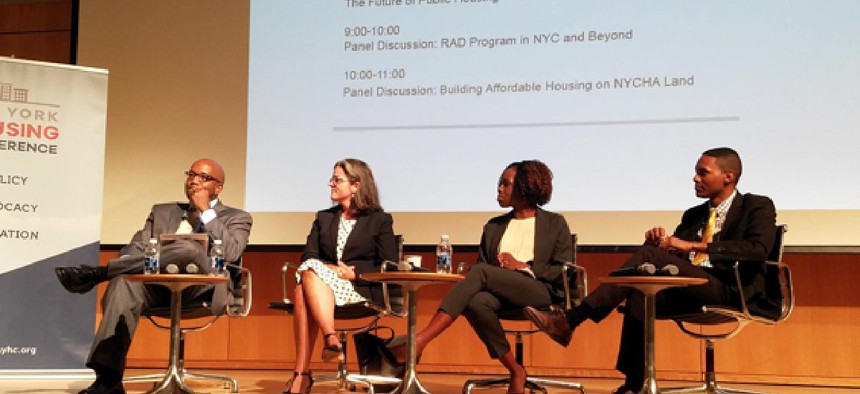NYCHA embraces HUD tool to stop “deepening decline”

In an attempt to address mounting funding challenges, the New York City Housing Authority is seeking allies among tenants and the federal government as it embraces a tool that could transfer nearly 15,000 apartments to private developers.
During a Sept. 22 forum hosted by the New York Housing Conference, some former skeptics of the U.S. Department of Housing and Urban Development’s Rental Assistance Demonstration (RAD) program, advocated for it. They included Regional HUD Administrator Holly Leicht and City Council Public Housing Committee Chair Ritchie Torres, who said it was potentially “the salvation of public housing.”
“We should comprare RAD not to some ideal, but to the alternative,” Torres said. “And the alternative is the deepening decline of public housing with no end in sight.”
Much of New York public housing is in serious disrepair and the pressure to find funding to support it grows by the day. Federal subsidies for public housing have leveled off across the country and NYCHA alone needs $17 billion for capital repairs. The de Blasio administration’s NextGeneration program incorporates RAD and other major initiatives - such as allowing developers to build on underused land - to reinforce it.
Because federal rules mandate that the properties are owned or controlled by a public or nonprofit entity, housing providers will have a major role to play in RAD conversions in New York and across the country.
The savings RAD projects are realized through the additional financial tools that become available to support capital expenses once an apartment's management is reorganized. Public housing units converted to Section 8 using RAD are given to developers and managers, who make repairs and get government subsidies to keep the rents permanently low. Those managers can also access tax credits and loans that public housing authorities can’t. (In New York, NYCHA will still own the land, but will lease properties to private developers.)
Supporters say that the Section 8 funding stream is a much more reliable source of money than that set aside for federal housing.
When Congress authorized RAD in 2012, it capped the number of units that could be converted to 185,000 across the country. (By comparison, NYCHA alone has 177,657 units.) That limit has already been reached and as of July the waitlist stands at more than 16,000 units.
“We are very much hoping that Congress will eliminate the cap altogether and make this a permanent program but at least in the next budget year, increase that cap,” Leicht said.
While cities like Baltimore and San Francisco have embraced the conversion tool, New York is “pretty late to the RAD game,” she said.
NYCHA has 5,200 units awaiting HUD approval across Manhattan, the Bronx and Brooklyn. When combined with another program that uses HUD Tenant Protection vouchers, about 14,700 units would be converted, a spokeswoman said.
Asked how many units NYCHA would like to see transferred to RAD, NYCHA Chair and CEO Shola Olatoye didn’t give specifics, but said that it was “one of the tools we have to look at” to improve housing infrastructure.
In July, NYCHA selected a development team for Ocean Bay (Bayside) in Far Rockaway, Queens, a 24-building complex that houses more than 3,500 people, and would need about $174 million to repair the building over the next 20 years. The team included RDC Development, Catholic Charities of Brooklyn and Queens and Ocean Bay Community Development.
While some critics have referred to the proposal as privatization - particularly the union that represents many of NYCHA’s employees - RAD’s backers said it would permanently peg the units to 30 percent of tenants’ income.
The Community Service Society in August wrote a letter to NYCHA, based on an independent roundtable it convened in March, recommending that it create a handbook for residents, continue the roundtable to watch the conversion process and help keep and absorb management staff at the converted developments. Vic Bach, a senior housing policy analyst at CSS, said there were real reason for residents’ fears about their management changing from NYCHA to an “unknown private entity” as well as concerns about unforeseen changes in federal rules.
“As an advocate,” Bach said, “there’s a fine line one has to hoe. We can’t be in the position of promoting the program, but our job is really to see that residents have maximum information in order to make those decisions for themselves and that they have agreed upon rights and protections throughout the experience.”
The panelists speculated whether Hillary Clinton or Donald Trump, the Democratic and Republican presidential nominees, would support RAD. “As we know, the Trump empire was built on government subsidized housing,” said moderator and NY1 anchor Errol Louis, referring to tax breaks and other incentives given to the developer to build his portfolio across New York.
“He gets more government subsidy than NYCHA,” Torres said.
Yesterday’s panel also included members of the Baltimore Housing Authority to discuss RAD’s implementation in that city, along with affordable housing developers. They talked about the first phases of building affordable and market-rate buildings on NYCHA land to a room full of tenants and housing advocates.
RFPs for half-market/half-affordable houses at Wyckoff Gardens in Brooklyn and fully affordable housing at sites in the Betances Houses are due next week, according to Nicole Ferreira, vice president of development at NYCHA.
